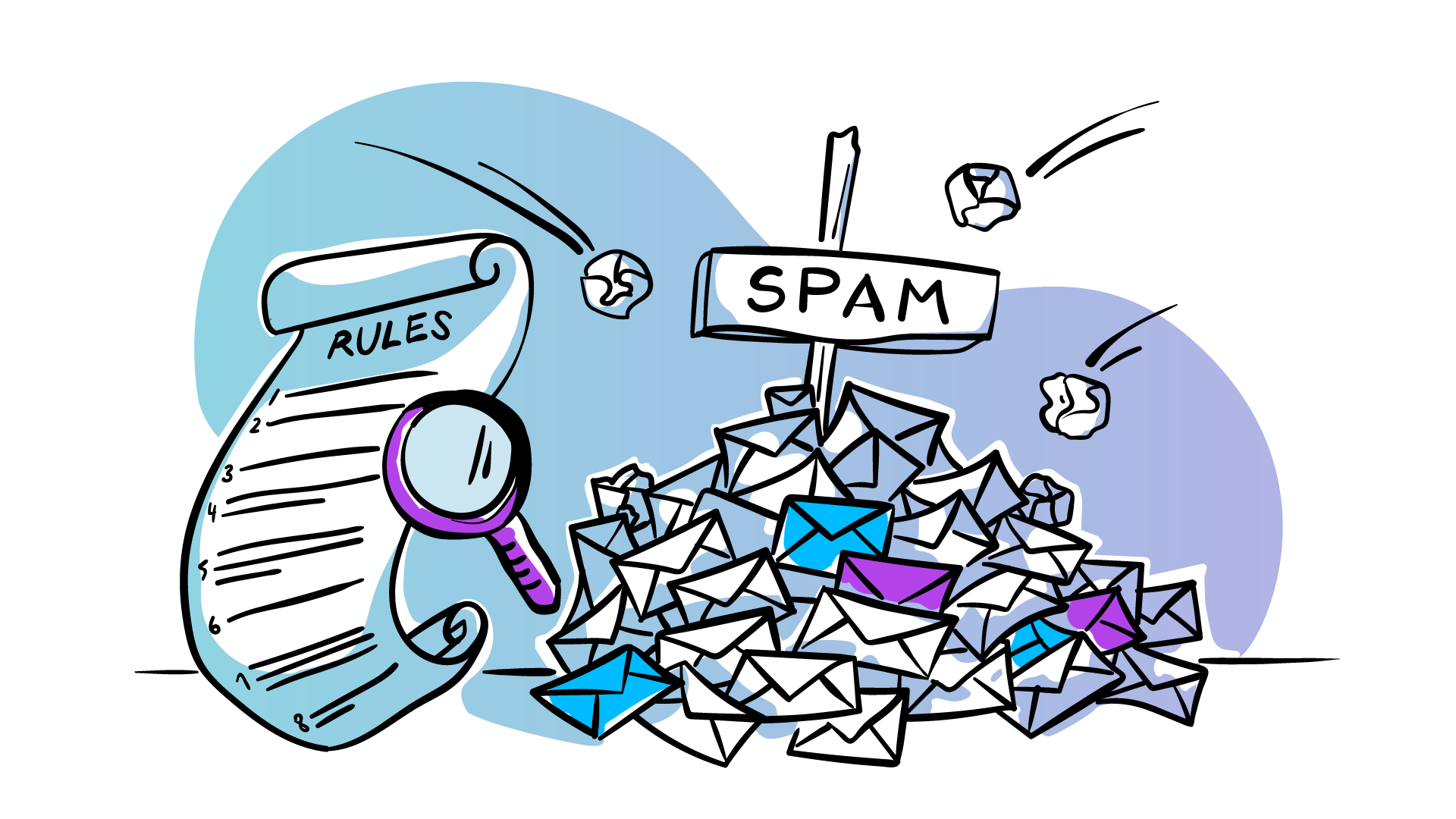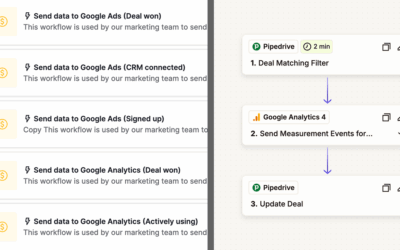About one in six emails never make it to the recipient’s inbox because they’re caught by spam filters. One key way you can prevent this from happening to your email campaigns is avoiding spam trigger words in your email subject lines and content.
There are hundreds of words and phrases that trigger spam filters because they’re frequently abused. And some of these words are actually commonly used by businesses like “laser printer” or “email marketing”.
List of 200+ spam trigger words
How can you tell if a word or phrase is spammy? Briskly test if it:
- is anxiety-inducing;
- creates a sense of urgency;
- sounds trashy or cheap;
- is too good to be true;
- contains anything illegal or malicious.
Here are 200+ words that trigger spam filters.
| Symbols | A | B |
| 0% | Access now | Bargain |
| 0% risk | Access for free | Believe me |
| 777 | Act now | Big bucks |
| 99% | Act immediately | Billing |
| 99.9% | Action required | Billing address |
| 100% | Additional income | Billionaire |
| 100% more | Affordable deal | Billion dollars |
| 100% satisfied | Apply online | Best offer |
| $$$ | At no cost | Bulk email |
| 4U | Auto email removal | Buy direct |
| C | D | E |
| Call me | Deal | Earn $ |
| Call now | Debt | Earn extra income |
| Calling creditors | Direct email | Earn money |
| Cancel at any time | Discount | Earn monthly |
| Cannot be combined | Do it now | Eliminate bad credit |
| Cards accepted | Do it today | Eliminate debt |
| Cash-out | Don’t delete | Email marketing |
| Cash bonus | Don’t hesitate | Exclusive deal |
| Click here | Double your cash | Expire |
| Congratulations | Double your income | Extra cash |
| F | G | H |
| Fantastic deal | Get it now | Hidden charges |
| Fantastic offer | Get out of debt | Hidden costs |
| Fast cash | Get paid | Hidden fees |
| Financial freedom | Gift certificate | High score |
| For instant access | Great deal | Home employment |
| For just $ (amount) | Great offer | Home-based business |
| For only | Guaranteed | Huge discount |
| Free access | Guaranteed deposit | Hurry up |
| Free bonus | Guaranteed income | |
| Free trial | Guaranteed payment | |
| I | J | K |
| Important information | Join millions | – |
| Important notification | Junk | |
| In accordance with laws | ||
| Increase sales | ||
| Increase traffic | ||
| Increase your chances | ||
| Incredible deal | ||
| Info you requested | ||
| Instant earnings | ||
| Initial investment | ||
| L | M | N |
| Laser printer | Make $ | Never before |
| Legal notice | Make money | New customers only |
| Life insurance | Millionaire | New domain extensions |
| Lifetime access | Million dollars | No age restrictions |
| Lifetime deal | Miracle | No credit check |
| Limited amount | Money back | No deposit required |
| Limited time offer | Month trial offer | No hidden fees |
| Loan | Monthly payment | No investment required |
| Lowest price | No purchase necessary | |
| Lowest rates | Now only | |
| O | P | Q |
| Offer | Please read | Quote |
| Offer expires | Potential earnings | |
| Once in lifetime | Pre-approved | |
| One hundred percent | Price protection | |
| Online biz opportunity | Print form signature | |
| Only | Problem | |
| Only $ | Prize | |
| Order now | Promise you | |
| Order status | Purchase now | |
| Outstanding values | Pure profit | |
| R | S | T |
| Rate | Sale | Take action now |
| Real thing | Sample | Talks about prizes |
| Refinance | Satisfaction guaranteed | The best rates |
| Refund | Save $ | This isn’t a scam |
| Removal | Save money | This isn’t junk |
| Removal instructions | Save big money | This isn’t spam |
| Request now | Save up to | This won’t last |
| Requires investment | Sent in compliance | Time limited |
| Reserves the right | Sign up free today | Traffic |
| Risk-free | Special promotion | Trial |
| U | V | W |
| Undisclosed recipient | Vacation | Wants credit card |
| Unlimited | Vacation offers | Warranty |
| Unsecured credit | VIP | Warranty expired |
| Unsecured debt | Visit our website | We hate spam |
| Unsolicited | We honor all | |
| Unsolicited | Web traffic | |
| Urgent | Website visitors | |
| US dollars | While stocks last | |
| Winner | ||
| X | Y | Z |
| – | You are a winner! | Zero chance |
| You have been chosen | Zero percent | |
| You have been selected | Zero risk | |
| Your chance | ||
| Your income | ||
| Your status |
How to A/B test your subject lines for spam trigger words
If you’re not 100% sure whether a word or phrase may trigger spam filters, you can always use A/B testing to trial your email campaign subject line on a subsegment of your list first.
Here’s how you can go about it:
- Decide on a few (2 or 3) options for subject lines you’d like yo use*;
- Choose representative groups of recipients from your database (2 or 3 accordingly);
- Send the same email to the groups of recipients, but with different the different subject lines you came up with in step 1;
- See and evaluate the open rates for each group: if either is significantly below the standard for your industry or lists, go with the one that performed better. If they’re equally good, you can choose the one you prefer or toss a coin! If both perform poorly, go back to step 1 (or perhaps take a look at more general email deliverability best practices).
*Remember that the point of A/B testing is getting results that you can learn from. Don’t test random subject lines — take time to work out the rationale.
What else can you do prevent your emails from landing in the spam folder?
Avoiding spam trigger words will not guarantee you end up in the recipient’s inbox. So, it’s worth taking a brief look at what qualifies as spam and how you can make sure your emails do not trigger anti-spam tools.
Spam refers to irrelevant emails usually sent to recipients without their consent.
Emails that trigger spam filters typically share a few distinctive characteristics:
- No targeting or personalization;
- Irrelevant business proposals;
- Urgency and scarcity in email subject lines;
- Links to dubious websites;
- No unsubscribe link.
And the scale of junk emails that gets sent out daily is astounding — around 14.5 billion (!) messages per day.
There is no unified criteria for judging what is junk and what is not, as every spam protection service has different algorithms. However, the general criteria can be sorted into four primary categories:
1. Unwanted emails
The most widespread characteristic of spammy emails is that the recipient never signed up for them in the first place.
If you make sure you only email people who expect to hear from you, then you’ll have taken care of the biggest trigger.
2. IP address reputation
If the IP address you use gets many abuse complaints, it’ll be blacklisted by mailing systems.
Be sure to actively monitor your IP’s email deliverability and bounce rates. Seeing the first metric falls while the second raises? It’s high time to pause the campaign and investigate the reason behind it.
3. Code
Fraudsters, especially ones in the Banking & Finance industry, are known for adding malicious pieces of JavaScript in their emails, e.g. rojanDownloader:JS/Nemucod.
As a result, any external code is now viewed as a potential source of threat — so, it’s better to avoid including it in content.
4. Content
When creating email content, follow simple courtesy rules:
- Include an opt-out option;
- Make visual or branding elements look pertinent;
- Test all external links you include and don’t misuse them.
Tips for writing less spammy emails
A key part of making sure your emails get delivered is simply writing great emails. If you do so, you simply do not give your recipients any reason to mark your emails as spam. Otherwise, it’s bad news for your domain reputation and your delivery rates.
So, here are 5 quick tips for writing less spammy emails.
Tip number 1: write with authentic tone
“Dear Sir or Madam,
My name is Jack Smith, I’m a sales manager of the ABC company.
I’ve looked through your website and think my company has something to offer you…”
Well… This is how phony emails start. A universal formula. You can replace names or titles — with no proper personalization changes.
However, there’s karma for spammers: even if the mail isn’t caught by spam filters, it will have low CTR. Because people are smart and no one will continue reading what they think to be fake.
The only way to be heard is to write authentic emails, ones that are genuine and personalized. And while authenticity is something that will be unique to you, here are a few ideas you can consider for your emaills:
- Anticipate the needs of your prospects (do your research!)
- Share facts, figures or social proof for your offering (e.g. how many companies trust you with their business or a short testimonial from someone)
- Write with respect (don’t be too formal or too friendly, at least not at first)
- Avoid unnecessary urgency or pressure (this can feel like emotional blackmail)
- Avoid manipulative language (such as “Do something or…”)
Tip number 2: make it easy to unsubscribe
If you don’t add an unsubscribe link and the recipient doesn’t want your emails, what do you think will happen? They will mark your emails as spam or report you.
So, adding a unsubscribe link helps avoid spam complaints and guard your email deliverability, especially if you plan on sending more than one email campaign (which we certainly hope you do).
Furthermore, you should make it easy to unsubscribe—do not hide the unsubscribe link or make it difficult to click on. That defeats the purpose.
After all, if you make it easy for people to opt-out of future emails, even if people do end up unsubscribing, they’re helping you clean your list. Simply puy, there’s no point emailing people who don’t want to hear from you—it’s a waste of your resources.
Tip number 3: create a memorable, non-spammy call to action
If you’ve gone through our B2B email marketing course, you’ll know that all your emails should have a call to action—and just one call to action.
But how to create a good CTA, one that actually works? While there’s no single formula, you can follow these best practices:
Don’t simply describe something — encourage actions
On average, we all receive 25-30 emails daily. Unless it contains something substantial, a long read has almost no chance of being read all the way through. Even if it’s well written.
For emails — be concise where possible. Try to shorten phrases and leave the essence that will hook the user.
Avoid words like “Click” for buttons; use “Claim offer” or “See the deals” instead. A good idea is to add a preheader that captures the essence of the email — whether this is a new offer, birthday gift, newsletter, etc.
Test email UI/UX on mobile
Too small buttons or too light font color may look good on a desktop; however, on small smartphone screens, these may look broken.
Finish the sentence, “I want to..”
One of the best tips for CTAs (in emails and elsewhere) is that a natural CTA finishes the following sentence: “I want to…” So, use for example, “Start my free trial” and not “Start your free trial”.
Tip number 4: don’t use ALL CAPS
Too many CAPS letters cause almost physical pain when reading the text. This concerns subject lines too!
Tip number 5: don’t use too many emojis
I hate to break it to you, but the golden era of emojis is behind. Nobody is surprised by them anymore. Even if your subject line with emojis looks good, it will most likely get lost in the recipient’s mailbox among similar emails.
This is how your Promotion tab may look like on any day:
If you want to use emojis, make sure they match the message and add value rather than noise.
Avoiding spam trigger words is just one part of getting your emails delivered and read. If you’d like to learn more about writing and sending emails that bring results, sign up for our B2B email marketing course.



